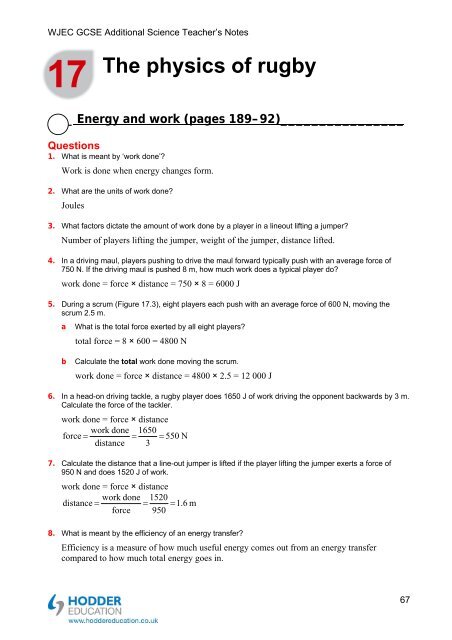Teacher's notes and answers to questions in the book - Hodder Plus ...
Teacher's notes and answers to questions in the book - Hodder Plus ...
Teacher's notes and answers to questions in the book - Hodder Plus ...
You also want an ePaper? Increase the reach of your titles
YUMPU automatically turns print PDFs into web optimized ePapers that Google loves.
WJEC GCSE Additional Science Teacher’s Notes<br />
17<br />
The physics of rugby<br />
_ Energy <strong>and</strong> work (pages 189–92)________________<br />
Questions<br />
1. What is meant by ‘work done’<br />
Work is done when energy changes form.<br />
2. What are <strong>the</strong> units of work done<br />
Joules<br />
3. What fac<strong>to</strong>rs dictate <strong>the</strong> amount of work done by a player <strong>in</strong> a l<strong>in</strong>eout lift<strong>in</strong>g a jumper<br />
Number of players lift<strong>in</strong>g <strong>the</strong> jumper, weight of <strong>the</strong> jumper, distance lifted.<br />
4. In a driv<strong>in</strong>g maul, players push<strong>in</strong>g <strong>to</strong> drive <strong>the</strong> maul forward typically push with an average force of<br />
750 N. If <strong>the</strong> driv<strong>in</strong>g maul is pushed 8 m, how much work does a typical player do<br />
work done = force × distance = 750 × 8 = 6000 J<br />
5. Dur<strong>in</strong>g a scrum (Figure 17.3), eight players each push with an average force of 600 N, mov<strong>in</strong>g <strong>the</strong><br />
scrum 2.5 m.<br />
a What is <strong>the</strong> <strong>to</strong>tal force exerted by all eight players<br />
<strong>to</strong>tal force = 8 × 600 = 4800 N<br />
b Calculate <strong>the</strong> <strong>to</strong>tal work done mov<strong>in</strong>g <strong>the</strong> scrum.<br />
work done = force × distance = 4800 × 2.5 = 12 000 J<br />
6. In a head-on driv<strong>in</strong>g tackle, a rugby player does 1650 J of work driv<strong>in</strong>g <strong>the</strong> opponent backwards by 3 m.<br />
Calculate <strong>the</strong> force of <strong>the</strong> tackler.<br />
work done = force × distance<br />
work done 1650<br />
force 550 N<br />
distance 3<br />
7. Calculate <strong>the</strong> distance that a l<strong>in</strong>e-out jumper is lifted if <strong>the</strong> player lift<strong>in</strong>g <strong>the</strong> jumper exerts a force of<br />
950 N <strong>and</strong> does 1520 J of work.<br />
work done = force × distance<br />
work done 1520<br />
distance 1.6 m<br />
force 950<br />
8. What is meant by <strong>the</strong> efficiency of an energy transfer<br />
Efficiency is a measure of how much useful energy comes out from an energy transfer<br />
compared <strong>to</strong> how much <strong>to</strong>tal energy goes <strong>in</strong>.<br />
67

















